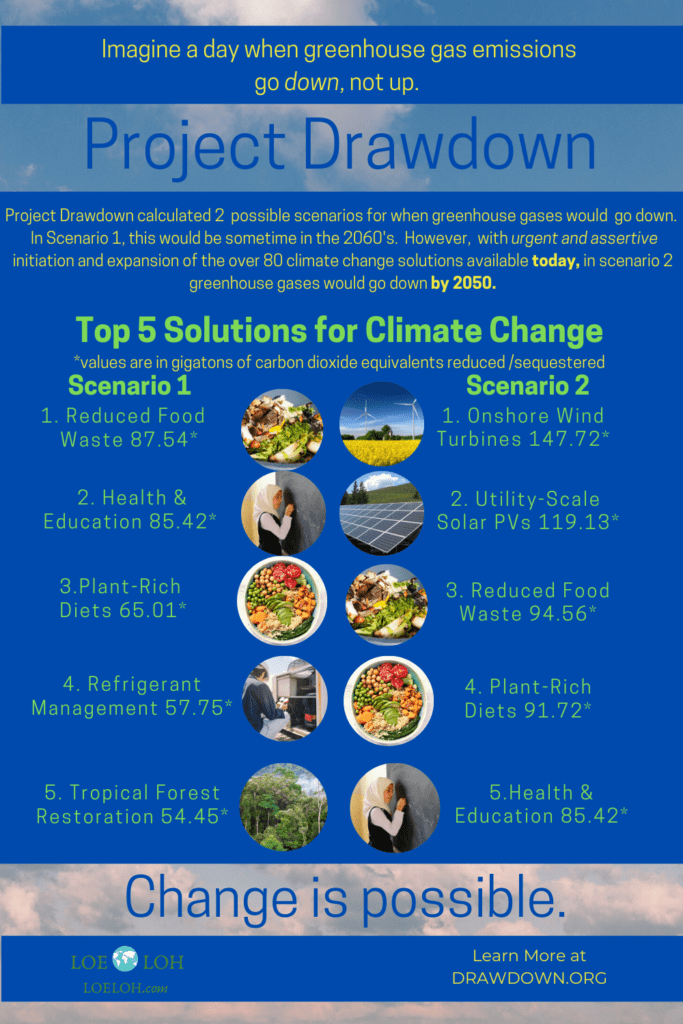This post contains affiliate links, which means I receive a small commission, at no extra cost to you, if you make a purchase using this link. Please see my disclosure for more details.

How do you love anything? A way to love something is to appreciate it. So, take a moment with me to appreciate that Earth is not just any planet, it is our home. If you are fortunate to be in a place that you call home and that you love, you take care of it right?
Well, our generation has come into adulthood with home a little hotter and with even more carbon dioxide. Earth is our home, and it’s our responsibility to figure out a better way to live in it because the status quo isn’t working and I am ready for change.
What do we need to change?
We need to reduce our carbon dioxide and other greenhouse gas emissions. There is a 97% consensus among climate scientists that climate change is occurring because of carbon dioxide and other greenhouse gases emitted in our atmosphere from humans burning fossil fuels. These emissions have occurred over the past 250 years and have resulted in global warming and climate change. (1, 2)
In this day and age to have a 97% agreement among any group, on anything, is a feat. We are a zealously passionate people. Some of us literally fight over which restaurant has the best chicken sandwich. Let’s use our passion to tackle one of the most important undertakings of our generation, climate change.
Scientists agree, it is the carbon dioxide and greenhouse gas emissions from human activity that have led to climate change. We need to change the way we live to drastically reduce our own carbon dioxide emissions to help curb some of the worst effects of climate change. So how do we reduce our greenhouse gas emissions?
How do we reduce our carbon dioxide emissions?
Project Drawdown’s Climate Change Solutions
Back in 2014, an environmentalist named Paul Hawken, started Project Drawdown. He gathered a team of 70 scientists from around the world to research solutions available today to achieve drawdown in the next 30 years (2020-2050). Drawdown they explained is the point at which carbon dioxide and other greenhouse gas levels in the atmosphere peak and then start to continuously drop. They culminated their research into the book called, “Drawdown: The Most Comprehensive Plan to Reverse Global Warming,” published in 2017. (3)
This year, the Drawdown team completed and published review of the solutions. With their review they confirmed it is possible for us to reach drawdown by 2050 but it will take us all, ardently working together towards the same goal. (4)
Project Drawdown’s review provided 2 different scenarios of the climate change solutions. Scenario 1 would be a less intense implementation of the solutions. Scenario 1 would keep the increase of the global average temperature to around 2 degrees Celsius. Drawdown would be reached between 2060-2070.
Scenario 2 is with more rigorous implementation of the climate change solutions. Scenario 2 would keep the increase of the global average temperature to around 1.5 degrees Celsius and we would reach drawdown between 2040-2050. Below are the top 5 solutions of each scenario. The number to the right of the solution is the gigatons (gigaton is equal to a billion tons) of carbon dioxide equivalents (GtCO2eq) that the solution will reduce/sequester over the next 30 years. (4)
TOP 5 Solutions for Climate Change, Scenario 1
- Reduced Food Waste, 87.45 GtCO2eq
- Health and Education, 85.42 GtCO2eq
- Plant-Rich Diets, 65.01 GtCO2eq
- Refrigerant Management, 57.75 GtCO2eq
- Tropical Forest Restoration, 54.45 GtCO2eq
TOP 5 Solutions for Climate Change, Scenario 2
- Onshore Wind Turbines, 147.72 GtCO2eq
- Utility-Scale Solar Photovoltaic, 119.13 GtCO2eq
- Reduced Food Waste, 94.56 GtCO2eq
- Plant-Rich Diets, 91.72 GtCO2eq
- Health and Education, 85.42 GtCO2eq

These are only 7 of over 80 solutions from Project Drawdown, and again all of the solutions are accessible today. The team at Project Drawdown gave us a guide to reduce our carbon dioxide emissions but where do we start?
Where do we begin to reduce our carbon dioxide emissions?
Begin with yourself. Which of these solutions gets you fired up?
I would start with reducing food waste and a plant rich diet. Later on, I will post on all of the solutions mentioned above and practical ways we can bring these changes into our homes and communities.
Do you like to track your progress?
You can calculate your carbon emissions using free on-line carbon footprint calculators to see where you are now. You may use this information to set goals for yourself to reduce your carbon footprint.
Carbon Footprint

Below is information on 4 different free on-line carbon footprint calculators. You do not have to calculate your carbon footprint in each of these. The first 3 calculators take a little longer because they ask for detailed information like home energy use. However, they also breakdown your carbon footprint into different categories. The last calculator from Conservation International does not ask as many details and takes about 5 minutes to complete.
If you choose to use all 4 calculators please note that there are differences in the units of the carbon emissions AND footprint of individual vs household. I will note this difference under each calculator’s description.
Carbon Footprint Calculators
Carbon Footprint is a consultant company in the UK assisting businesses in managing their carbon. Their carbon footprint calculator measures an individual’s carbon footprint in metric tons. Their calculator includes an option to change the language and country for the calculator.
Cool Climate Network is a network of climate researchers and organizations from all over the world with a goal to grow climate solutions. Their carbon footprint calculator measures your household’s carbon footprint in metric tons. On the last page of the calculator they include ways you can reduce your carbon emissions, the estimated costs, and savings.
EPA, the Environmental Protection Agency is a United States federal government agency. Their calculator measures an individual’s carbon footprint in pounds. This calculator also provides options for reducing your carbon emission. These options are embedded in the calculator as you go along. If you would like to convert the outcome of pounds into metric tons, you may divide the pounds by 2,204.6 to equal metric tons. (5)
Conservation International is a U.S. based environmental organization and their calculator is sponsored by SC Johnson. Their calculator provides the option at the beginning to calculate the carbon footprint of either your household or individual. The carbon footprint is in tons. I have reached out to clarify if their calculator is in U.S. standard ton or Metric tons but have not heard back. (NTS: continue to check with conservation international on units). Based on my personal calculations, I believe their calculator is in metric tons. At the end, they provide the option to purchase carbon offsets.
My Carbon Footprint
I based my own carbon footprint on how I lived in 2019 and my carbon footprint was…
21.46 CO2 metric tons.
The average carbon dioxide emissions for a person in the U.S. is 16.5 metric tons. The world target for individual carbon emissions is 2 metric tons. I know I am a part of the carbon dioxide emissions problem. Now, I want to be a part of the change. I also know I am not alone on this journey because millions of people gathered around the world last year for the Global Climate Strike. (7) If you have stuck with me for this long through this post, you are probably interested in reducing your carbon dioxide emissions too. So, let’s go!
Resources:
1: Scientific Consensus: Earth’s Climate is warming scientist consensus: Earth Observatory NASA.gov (Updated 2020, March 06). Retrieved from https://climate.nasa.gov/scientific-consensus/
2: Climate Change: Atmospheric Carbon Dioxide: NOAA Climate.gov. (2020, February 20). Retrieved from https://www.climate.gov/news-features/understanding-climate/climate-change-atmospheric-carbon-dioxide
3: Hawken, P. (2017). Drawdown. D: the most comprehensive plan ever proposed to reverse global warming. Penguin Books.
4: The Drawdown Review, Project Drawdown. (2020) Retrieved from https://www.drawdown.org/
5: Pounds into Metric Ton Conversion: Wight Hat Ltd. (2018 July 22). Retrieved from https://www.metric-conversions.org/weight/pounds-to-metric-tons.htm
6: Carbon Footprint Calculator: Carbon Footprint Retrieved from https://www.carbonfootprint.com/calculator.aspx
7: Millions hit the streets for global climate change strike: CBS News. (2019 September 20). Retrieved from https://www.cbsnews.com/live-news/global-climate-change-strike-protests-today-2019-09-20-live-updates/


Wonderful post-I’m looking forward to calculating my carbon footprint and then driving that number toward 2!
Thank you very much C! We will work on getting to 2 together. 🙂
Yes, indeed, an awesome post! The Project Drawdown’s scenarios do seem very doable and the same for us all to reduce our own carbon footprint. You can count me in on flattening and heading toward 2, as well. Oh! To get to #2.
Thank you RL! It is empowering the climate change solutions that Project Drawdown provide. Awesome! The more of us working to 2 the faster we will reach drawdown. We can do this!